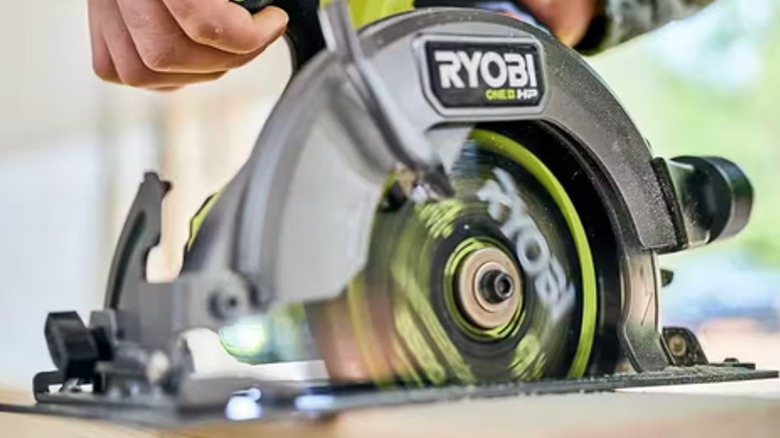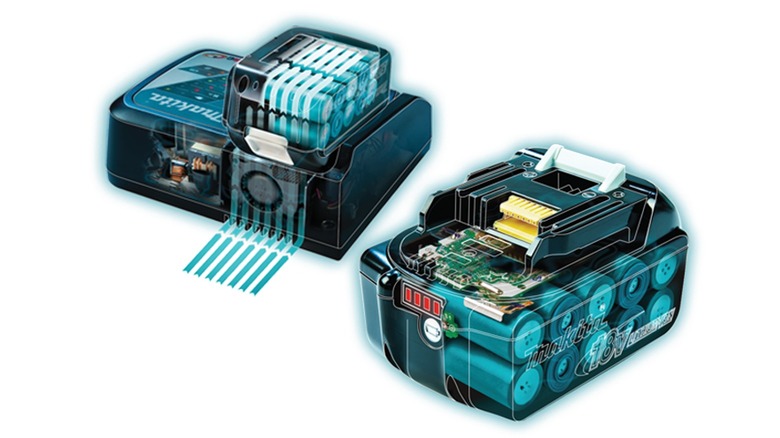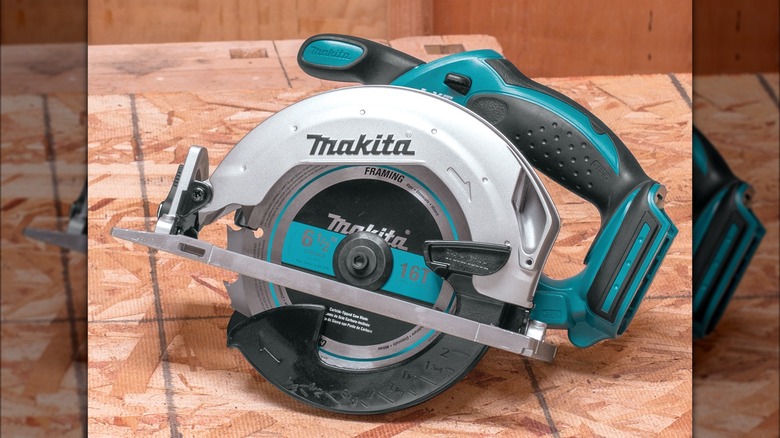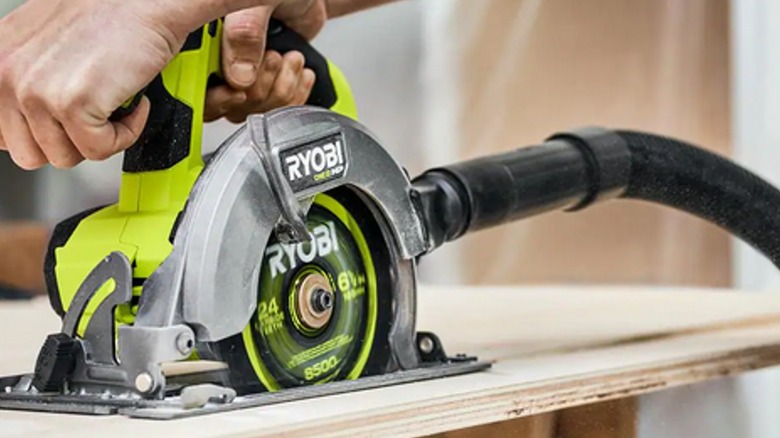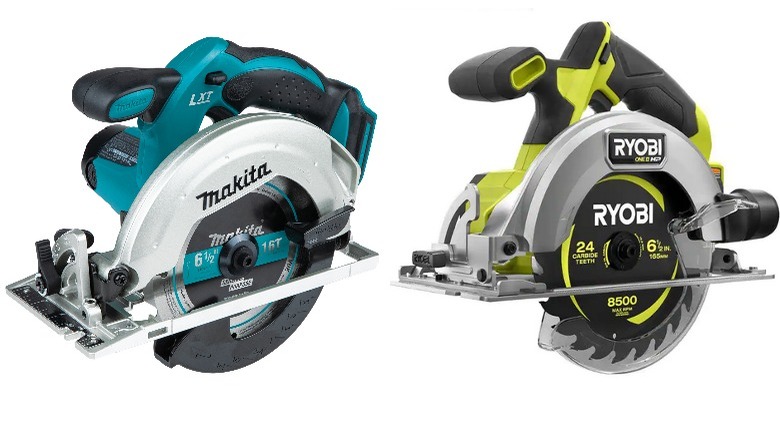Makita Vs Ryobi: Which Cordless Circular Saw Is The Better Buy?
The circular saw is an incredibly useful tool. It takes up a small amount of space, and its portability makes it ideal for cuts that have to be done outside the shop. Going cordless adds even more possibilities. Not only will you no longer have to struggle with tripping over messy wires while carrying power tools, but you'll also be able to use the saw in locations that don't have easy access to electricity.
There are a few brands that make these versatile saws, but some of them make better products than others. Makita and Ryobi are two popular brands that you might be considering. Makita is a Japanese company that has been around for over a hundred years and is a trusted brand. Its tools can be found in shops around the world. Ryobi has a slightly different history. It started out as a Japanese-owned company in 1943, but its U.S. power tools division was acquired in 2000 by an American company called Techtronic Industries. It subsequently became the official brand of Home Depot, which is why you'll never find Ryobi tools for sale at Lowe's.
Both companies have an excellent selection of quality power tools. But some of you might be wondering what the difference is between each of their cordless circular saws, and which one is the better buy. There are a few size options from both brands, but for the sake of comparison, we'll be looking at the Makita 18V LXT 6-1/2 in. and the Ryobi One+ HP 18V 6-½ in.
Battery
The first thing to consider when choosing a circular saw is whether you already have any cordless tools from either brand. Nearly every modern tool manufacturer has its own battery system. These batteries are typically categorized by their voltage output. Many tools of the same brand can use batteries interchangeably, so long as they require the same voltage. For this reason, it's usually a good idea to stick with one brand of wireless tools. It allows you to invest in a single battery ecosystem, and you don't need to fill all of your power outlets with chargers from different brands.
That said, Makita and Ryobi's batteries are slightly different. They are both 18V Lithium Ion batteries, but Makita's LXT battery system has a reputation for being one of the most sophisticated on the market. TheSawGuy reported that LXT is more efficient, more reliable, and tends to have a little bit more longevity. It uses Star Protection Computer Controls to protect against overload, over-discharge, and overheating. Their saws also have a built-in fan system to keep motors and batteries cool so that they last longer. The LXT batteries also work with some of Makita's really strange cordless tools which most other brands don't produce.
That isn't to say that the Ryobi One+ system is bad. Many users have found it more than sufficient for their needs. But those who intend to put in long hours of cutting without recharging their batteries might be better off with Makita's LXT.
Power
The next important factor to consider is the speed and power of the blade's rotation. A weak motor can cause messy cuts and even make a saw blade jump if it hits a particularly hard spot like a knot in the wood. That isn't to say that any of the saws made by Makita or Ryobi are dangerous compared to other cordless circular saws, but it's certainly worth looking into which of them produces more raw power. According to SGS Engineering, "The speed your power tool's motor rotates the saw blade will dictate how much control you'll have over your tool when in use. Free-load speed is a great indicator of raw sawing power, so the higher the revolutions per minute (RPM), the better! The free-load-speed will vary vastly from saw to saw, but typically you'll see an RPM anywhere between 2,700 to 5,000+ RPM."
The Makita 18V LXT offers 3,700 RPM. This is within the expected parameters, if not overly impressive. Some of you might be surprised to learn that the Ryobi One+ HP 18V actually offers 4,900 RPM. That is a significant increase in power. Of course, the amount of revolutions per minute required for a given job varies depending on the type of material you're trying to cut. 3,700 RPM should be more than adequate for cutting through pine 2X4s and most other materials, but it might just be easier to cut certain kinds of metal and hardwood with a little extra juice.
Design and Features
These saws have a lot in common. Both have compact, cordless designs. They both have rubberized grips for more comfort while using them. They each have 6.5 inch blades with a 2.25 inch cutting capacity and a 0-50-degree bevel capacity. Both use brushless motors which keep them cooler thereby extending battery life. Finally, both saws also include a three year limited warranty. They're very similar in a lot of ways, but they also each have a few special features listed in their specifications that might help you pick which one is better for your needs.
To start, the Makita weighs 7.3 lbs. while the Ryobi only weighs 5.0 lbs. This makes the Ryobi slightly easier to carry, but lighter weight can be kind of a mixed bag. Part of the reason for the weight disparity is the Makita's "heavy-gauge, precision-machined base" which helps keep cuts smooth and adds to its durability. This might lead some to prefer a slightly heavier option. The Ryobi has a few tricks up its sleeve though. It has a vacuum dust adaptor to help keep clean-up to a minimum and it has an onboard LED work light to help with visibility. These lightweight upgrades make the Ryobi more versatile, though perhaps not quite as sturdy.
Price and Verdict
The last factor to take into account is price. Home Depot is currently selling the Makita 18V LXT 6-1/2 in. for $159.00, and the Ryobi One+ HP 18V 6-½ in. is going for $99.00–meaning the Ryobi is a full $60 cheaper. You might find the Makita on sale through other retailers, but the Ryobi seems to be markedly more affordable at MSRP.
Makita is the clear winner in terms of battery quality, but the budget Ryobi saw is surprisingly viable in every other category. It has more horsepower, more features, and is available at a lower price. This not only makes the Ryobi the bargain option, but perhaps the better tool overall. Those who need a circular saw for a specific project and aren't particularly interested in building up a power tool collection will probably be better off saving their money and going with Team Green. It's cheaper and more powerful, and the dustport and LED also make it more user-friendly.
The decision is somewhat harder for those who are thinking about building up a tool collection though. You might be tempted to lean toward the Makita saw since the battery system is so much better, in spite of the saw's potential shortcomings. Both tools are valid options. It just depends on your individual needs.
